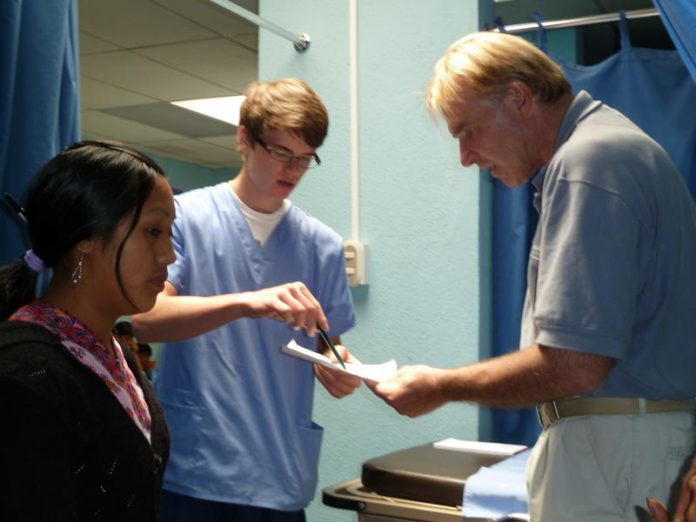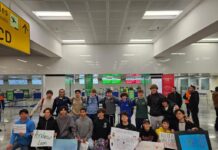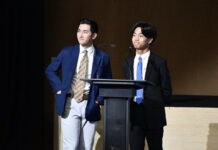From April 6 to 10, 2011, students and faculty from Jesuit and three doctors and one social worker went to Guatemala to help the sick of the country. They worked with an organization called The Vamos Mayor in two clinics, one in Panajachel and one in Nahualá.
All the teacher and students were from Jesuit’s Medical Society: science teachers Mrs. Jan Jones and Mr.
Ben Kirby, Peter Chung ‘11, Vinay Srinivasan ’12, Jimmy Nawalaniec ‘11, John Simion ’12, Philip Morton ’12, Spencer Adamson ’11, and Synyoung Li ’11. The doctors who went were Dr. Yolanda Brady, Dr. Rana Pasco, and Dr. Rhonda Walton; the social worker who went was Ms. Kathy Bennett. All of these people contributed to the curing of people who don’t have the same opportunities for health care that we do in America.
The trip began before the group even boarded the plane. All the medicines that Jesuit students donated to the medicine drive held earlier this year had to be checked and cleared by the Ministry department. The filling out of paperwork for expiration dates and medicines was a tedious, but necessary task. The ministry would then clear all of the medicine being brought into the country and then all of the previously filled out paperwork had to be put into the individual bags for each medicine. Additionally, Mrs. Jones had to fill out twelve pages of paperwork just to get antibiotics ordered to be cleared for the trip. This is because few people can donate antibiotics, so Mrs. Jones has to use a program called the Medical Assistance Program (MAP). Mrs. Jones told me that, “the paperwork has to be the hardest part,” and with all of the effort it takes just to get the drugs into the company, it’s impossible not to believe her.
Getting on the plane was also troublesome. Bags of medicine had to be packed and weighed for the medical society to have ease boarding the plane. It was difficult to have 450 pounds of medical equipment divided in bags under 50 pounds each, so that the bags would fly free on the Continental plane they went on.
Upon arriving in Panajachel, the poverty is visible before landing. The houses are made of adobe and straw, and the roads are dirt. The group was stopped by the security at the airport, even though they had been cleared by the Ministry, which the president is involved with. Eventually they made their way out of the airport after a 45 minute delay and continued their journey.
The first day of their trip in the Panajachel clinics started out a little rough. Everyone had been up since 3 in the morning to board the plane, they had been delayed at the airport, and when they arrived at the clinic they had to start right away without having much time to get organized. Mrs. Jones told me that this was hard because, “the doctors want to treat the overall health of the patient, not just the immediate need. [The doctor’s] want the [patients’] histories; so probably what we should have done, because we didn’t get to the clinic until about 3 o’clock, is set up and organize everything, and then start the next day.” Mrs. Jones thinks that she will be doing that next year rather than having to work late hours like they did this year.
Even though things seemed to be tough everyone still had a lot of fun. Mrs. Jones told me that the Jesuit students were trying to teach the young boys in Panajachel how to brush their teeth, something we as Americans probably don’t even think about, and the boys just didn’t seem to get it. Although when one of the Jesuit students showed his white teeth to the boys and told them if they brushed their teeth they would get the “chicas” (Spanish for girls), all the boys seemed to understand the importance of brushing their teeth. Unfortunately, not all things are as easy as teaching the boys to brush their teeth. In America our doctors have a plethora of equipment and medicine at their disposal.
In Guatemala, it’s not the same case. They don’t have all of the equipment they need and sometimes diagnosing and treating a patient can be difficult. Mr. Kirby said that his eyes were opened when he, “saw the lack of health care, and
health care knowledge. It was hard to see people who didn’t know how to manage their health in the way that we do, which affects their longevity. Some of the things Mrs. Jones says she saw were, “a case of leprosy; a case of Turner syndrome; and a baby who lacked muscle tone of any kind, a genetic disorder.” Without the proper equipment it was impossible to treat the baby’s disorder, a heart wrenching circumstance for the doctors.
Our Jesuit students contributed in many ways throughout the trip. They did triaging, which is the process of getting the sickest patients to the doctors first. They did this by getting name, height, weight, blood pressure, body temperature, and pulse. Then they would send the patient to the doctor who could help them the best. Jimmy Nawalaniec said that, “by the end of the trip, the doctors were letting us talk to the patients and suggest a diagnosis and treatment for their approval; it was very hands on.” The students seemed to really enjoy this experience; John Simion had this to say about the mission
trip: “I would say I really loved working with the people especially the kids, all the people were amazing.”
Treating everyone was no small task and Mrs. Jones believes “the students who went were just absolutely fantastic!” Mr. Kirby was also happy with the way things went, he was happy to see the natives being treated and said that the biggest reward was seeing “the passion that [the natives] have for life and the way that they didn’t allow their challenges to get in the way of being spiritual and social beings.” Jimmy Nawalaniec felt the same way saying, “I would definitely go on this trip again, not only for the medical, educational experience, but also for the natives we treated. Even after the long hours inside the unairconditioned clinic, the look of gratitude on the patients’ faces after we treated them and gave them medicine was incredible. After seeing that, we knew we were instilling hope into a downtrodden community. I wish I could go back next year to go on this trip again. It was vastly interesting and rewarding.”
As a final note, the most important thing to remember about these mission trips is that you can help, when the Medicine drive comes around each year, it is essential not only as a Jesuit student, but as a human being, to help those in need. Going to CVS isn’t out of the way and that $15 could save someone’s life, treating the flu in America is easy, but when someone gets the flu in Guatemala it could end their life. This past year we ran out of supplies, what could you have done differently?






